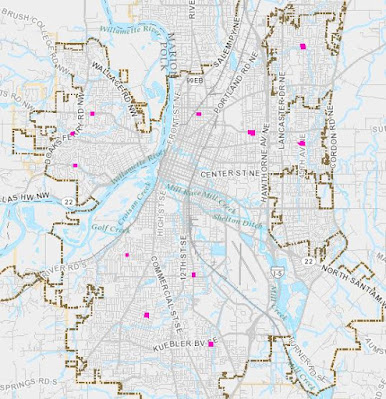Back in 1927, just after Salem adopted its first zoning law, a puff piece, perhaps even advertorial, promoted new housing and development in "the so-called North Salem district," mainly in the area we call Highland now.
 |
| March 2nd, 1927 |
After a long wind-up, the writer says something we recognize in Our Salem and hope for the future:
One distinct advantage of the district is that commercially it is almost self sustaining. Practically every daily necessity may be bought with just a short walk instead of the long trip of 25 or more blocks to the main business section of the city. Whether it being a pound of meat for dinner or theater tickets for evening's entertainment you can get it in north Salem with little inconvenience.
 |
| Slightly different hub sites at different times |
The piece references what we now call the old Hollywood, the "North Capitol commercial center...[at] Capitol street and Fairgrounds road."
 |
| More on the area, March 2nd, 1927 |
Much earlier in the century there was a store at mid-block at 746 Highland Avenue across the street from Bert Hoover's old home on the corner of Hazel and Highland. It seemed to have operated both as home and as store. It cycled through several different owners also.
 |
| May 8th, 1909 |
 |
| March 4th, 1911 |
 |
| July 30th, 1920 |
 |
| April 8th, 1922 |
 |
| May 7th, 1925 |
A little later, starting in the 1930s, kitty corner from the Hoover home, a different corner store went up, and this is the one most people will remember. Clearly this stretch of Highland Avenue served a demand for small-scale retail.
 |
| On the corner of the 800 block |
It is this block that is now proposed for a "Neighborhood Hub."
 |
| Hub concept for Highland Ave |
On the one hand, this is a great idea! It formalizes an historical store location and draws on a latent kind of commercial energy that might be reawakened from dormancy.
But two concerns might hamper it a little, one about the power of planning, the other about number of customers.
As we see from this little historical sketch of Highland, and as we know from any retail history generally, retailing is unstable. The store at 746 Highland cycled through multiple owners and operated as a home and store at different times. In the 1930s, the grocery shifted a few lots east to the corner site. At the same time, the small strip on Fairgrounds at Capitol developed into old Hollywood.
The Neighborhood Hub zoning as proposed might not be flexible enough or plentiful enough to accommodate the realities and vicissitudes of small-scale retailing.
 |
| Proposed hubs in pink (vision map) |
As we've noted with the Highland site, several of the proposed hub sites draw on existing or historical attractors:
- The 800 block of Highland Avenue, with a old corner store
- Pringle at Madrona, with an old gas station
- Market at 45th, the old Badger Corner and near a school
- Ward and 45th, near a school
- Lansing and Sunnyview, with a church building
- Hansen and Holiday, an empty corner lot near a school
- Orchard Heights by the fire station and school
Other proposed hub sites appear to leverage an empty lot, but do not otherwise seem to have any historic or existing attractors nearby (though it is possible an old store or something burned down on a now-empty lot, and there could be more to say on any of them).
- Lone Oak at Idylwood, with houses only
- Barnes near Reed Lane, with several empty lots
- Doaks Ferry and Ptarmigan, with an empty corner lot
- Eola Drive near Kaley Ave, with one or more empty lots
We should consider designating a lot more of potential hubs, and let the market have more opportunity to sift through them and choose which ones flourish. Just marking them on a map is not going to develop them, and the viability of some sites might surprise us - positively or negatively. Maybe every corner lot on a collector or minor arterial should receive this zoning and then we would be better able to "discover" where was the demand for them. This is the kind of modest upgrade in intensity of uses that Strong Towns has argued should be automatically allowed by-right. In the absence of this, we should specify and make easier a process to create new hubs, or to grow the zoning on an existing one, so that the city can respond more easily to entrepreneurs and market forces, who may be quicker to identify a site's potential than our cumbersome central planning processes.
The second concern is that issue of the penumbra of residential upzoning. Around these hubs we will almost certainly need a greater number of customers in order for them to have any hopes of flourishing. Surrounding them with single-detached housing only for three or four blocks is a recipe for much less certain success.
These hubs need more middle housing immediately adjacent, and without that move, they will be just colors on a map.
HB 2001 compliance will address some of this, but it may be that we need a stronger package of residential upzoning around any proposed hub.
It will be very interesting to follow the conversation around the hub concept. Some neighbors married to expanses of lawn and driveway zoning will be reflexively critical and not give them any reasonable thought. But others will have useful hyper-local knowledge about their immediate neighborhood and may have suggestions to refine or improve the proposed sites and scope.
There's a lot of potential here, but the pilot currently on the table may be too modest.


1 comment:
Yes, there's a good argument to be made for expanding both Neighborhood Hub and R4 designations, esp. along minor arterials.
Post a Comment